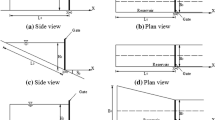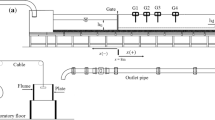Abstract
A review of the information available in the literature is given, and new experimental data on the depth and discharge at the dam site after a total and a partial dam break are presented. It is shown that in the case of a partial dam break with the formation of a rectangular breach, the specific discharge per unit width of the breach is higher than the specific discharge in the case of a total dam break with the same excess initial energy in the headwater.
Similar content being viewed by others
References
J. J. Stoker, Water Waves, Interscience, New York (1957).
V. V. Ostapenko, “Dam break flows over a bottom step,” J. Appl. Mech. Tech. Phys., 44, No. 6, 495–505 (2003).
V. Yu Liapidevskii, “Shallow-water equations with dispersion. Hyperbolic model,” J. Appl. Mech. Tech. Phys., 39, No. 2, 194–199 (1998).
V. B. Barakhnin, T. V. Krasnoshchekova, and I. N. Potapov, “Reflection of a dam-break wave at a vertical wall. Numerical modeling and experiment,” J. Appl. Mech. Tech. Phys., 42, No. 2, 269–275 (2001).
A. A. Atavin, O. F. Vasil’ev, A. F. Voevodin, and S. M. Shugrin, “Numerical methods for the solution of one-dimensional problems of hydraulics,” Vodn. Resursy, 4, 38–47 (1983).
V. V. Belikov, A. A. Zaitsev, and A. N. Militeev, “Mathematical modeling of complex segments of large riverbeds,” Vodn. Resursy, 29, No. 6, 698–705 (2002).
G. Colicchio, A. Colagrossi, M. Greco, and M. Landrini, “Free-surface flow after a dam break: A comparative study,” Schi.stechnik, 49, No. 3, 95–104 (2002).
V. Yu. Liapidevskii, “Structure of a turbulent bore in a homogeneous fluid,” J. Appl. Mech. Tech. Phys., 40, No. 2, 238–248 (1999).
O. F. Vasil’ev “Mathematical modeling of hydraulic and hydrological processes in water reservoirs and water courses: Review of the research performed at the Siberian Division of the Russian Academy of Sciences,” Vodn. Resursy, 26, No. 5, 600–611 (1999).
V. V. Belikov and A. N. Militeev, “Two-layer mathematical model of catastrophic high waters,” Vychisl. Tekhnol., 1, No. 3, 167–174 (1992).
V. I. Bukreev, A. V. Gusev, and V. V. Ostapenko, “Open-channel waves that form after removal of a shield ahead of an uneven shelf-type bottom,” Vodn. Resursy, 31, No. 5, 540–545 (2004).
V. I. Bukreev, A. V. Gusev, and V. V. Ostapenko, “Free-surface discontinuity decay above a drop of a channel bottom,” Izv. Ross. Akad. Nauk, Mekh. Zhidk. Gaza, 6, 72–83 (2003).
P. G. Kiselev, Handbook on Hydraulic Calculations [in Russian], Gosénergoizdat, Moscow (1957).
V. I. Bukreev and A. V. Gusev, “Initial stage of generation of dam-break waves,” Dokl. Ross. Akad. Nauk, 401, No. 5, 619–622 (2005).
V. I. Bukreev, “On the critical velocities and depths for nonuniform stationary flow in an open channel,” Vodn. Resursy, 31, No. 1, 40–45 (2004).
R. F. Dressler, “Comparison of theories and experiments for the hydraulic dam-break wave,” it Int. Assoc. Sci. Hydrol., 3, No. 38, 319–328 (1954).
V. I. Bukreev, A. V. Gusev, A. A. Malysheva, and I. A. Malysheva, “Experimental verification of the gashydraulic analogy by the example of the dam break problem,” Izv. Ross. Akad. Nauk, Mekh. Zhidk. Gaza, 5, 143–152 (2004).
V. I. Bukreev and A. V. Gusev, “Gravity waves due to discontinuity decay over an open-channel bottom drop,” J. Appl. Mech. Tech. Phys., 44, No. 4, 506–515 (2003).
V. I. Bukreev, “On the water depth in the breach during a partial dam break,” Izv. Ross. Akad. Nauk, Mekh. Zhidk. Gaza, 5, 115–123 (2005).
V. I. Bukreev, “Undular jump in open-channel flow over a sill,” Appl. Mech. Tech. Phys., 42, No. 4, 596–602 (2001).
Author information
Authors and Affiliations
Additional information
__________
Translated from Prikladnaya Mekhanika i Tekhnicheskaya Fizika, Vol. 47, No. 5, pp. 77–87, September–October, 2006.
Rights and permissions
About this article
Cite this article
Bukreev, V.I. On the discharge characteristic at the dam site after dam break. J Appl Mech Tech Phys 47, 679–687 (2006). https://doi.org/10.1007/s10808-006-0104-2
Received:
Revised:
Issue Date:
DOI: https://doi.org/10.1007/s10808-006-0104-2




